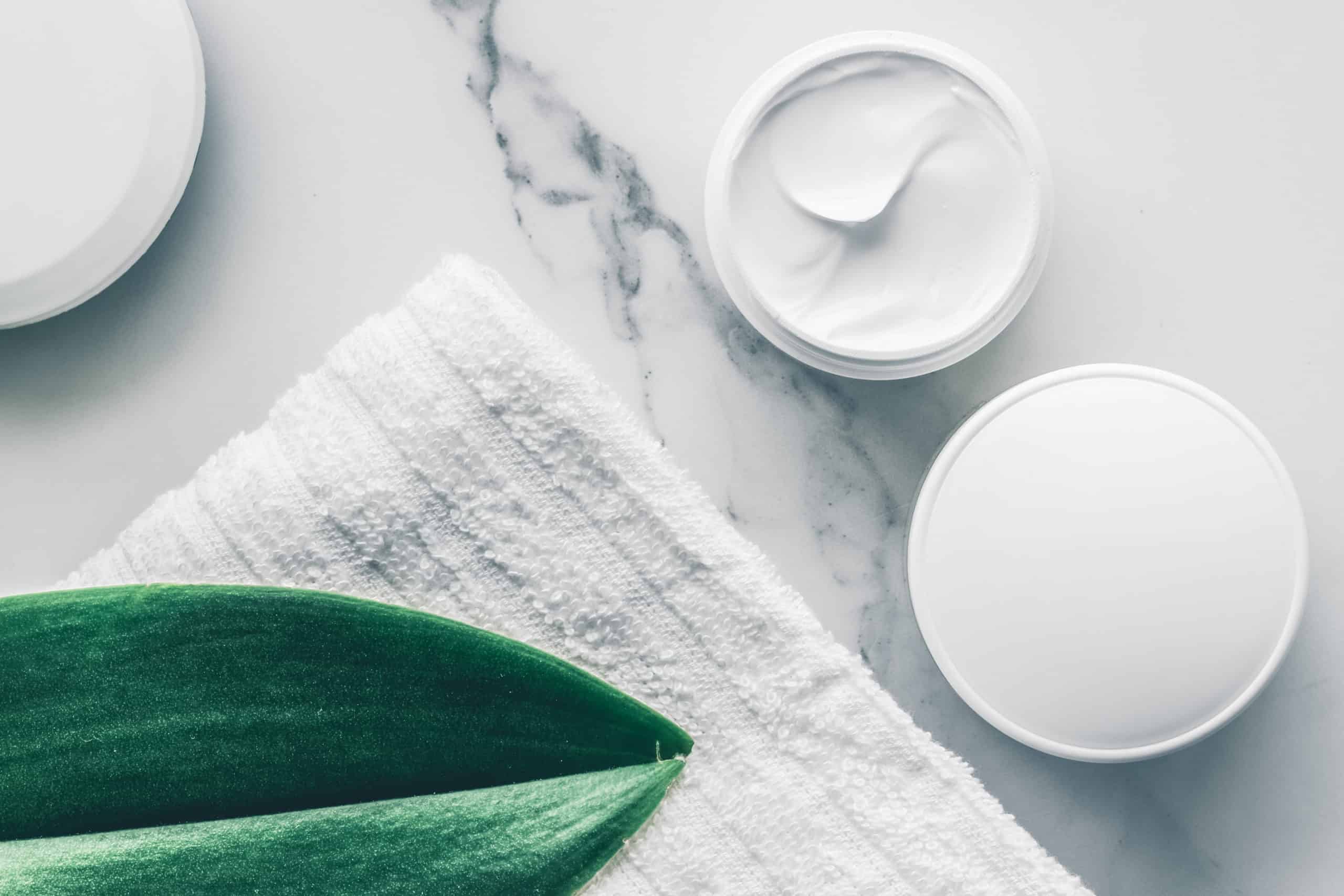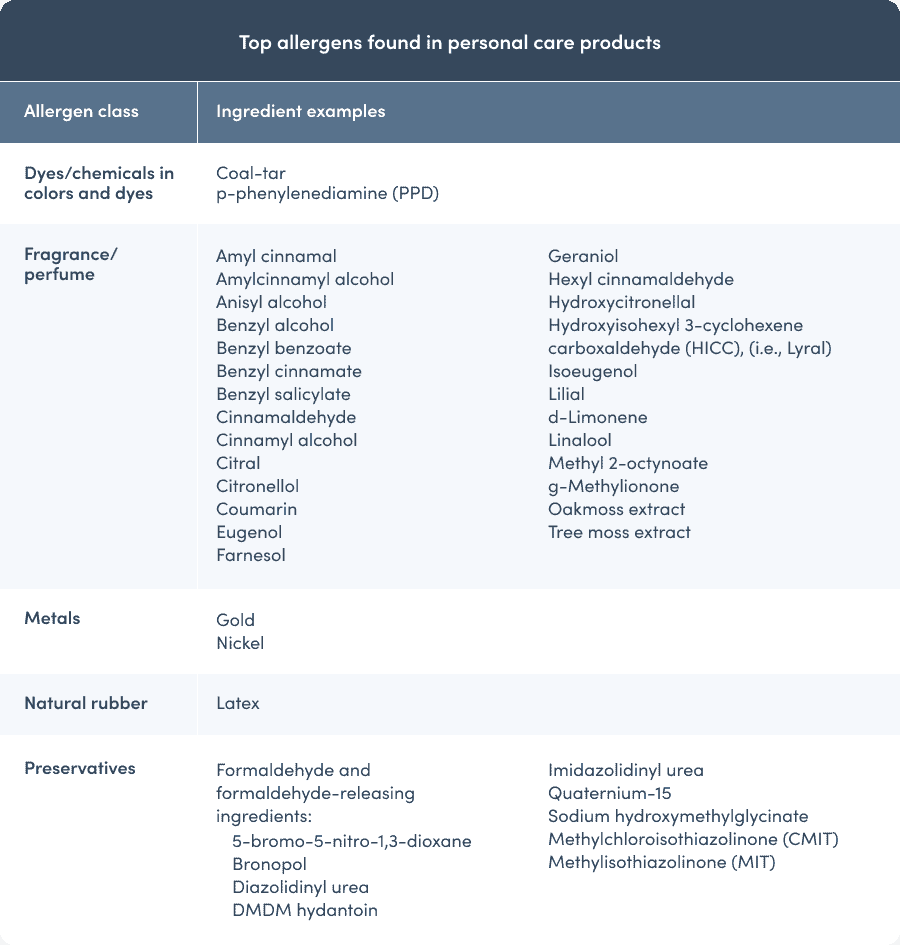What are personal care products?
Personal care product (PCP) is a broad term that describes a variety of products used for cosmetic or therapeutic purposes. PCPs are generally not ingested but are used externally or for oral health. (8) Examples of PCP types include:- Aromatherapy (e.g., essential oils)
- Body care (e.g., deodorant, body lotion and balm, body wash, liquid and bar soap)
- Feminine products (e.g., menstrual cups, intimate cleansers and wipes)
- Haircare (e.g., shampoo, conditioner)
- Relaxation (e.g., bath, foot rub, foot soak products)
- Muscle and joint pain relief (e.g., cream, gel, scrub)
- Oral health (e.g., toothpaste, mouthwash, whitening strips)
- Recreational (e.g., bug repellant, neck pillow)
- Sexual health (e.g., intimate cleansers, lubricants)
- Skincare (e.g., cleanser, toner, moisturizer, exfoliator, oil, lip balm, serum, eye cream)

Chemicals found in personal care products can contribute to your overall toxic load.
Personal care product regulations
In the U.S., the Food and Drug Administration (FDA) regulates PCPs based on the specific product category they fall under. Many PCPs are considered cosmetics, including deodorant, moisturizer, shampoo, and skin cleanser. Products that are also intended to treat a condition are considered to be both cosmetics and drugs, such as anti-dandruff shampoo, antiperspirant deodorant, fluoride-containing toothpaste, and moisturizers with sun-protection claims. (8) Products that fall under the cosmetic category are not subject to FDA approval before entering the marketplace. In these cases, the manufacturer is responsible for ensuring the safety of ingredients and products before sale. The one exception is color additives, which must be approved by the FDA to be used as a cosmetic ingredient. (8)Quality considerations
Determining the quality of personal care products involves considering ingredient safety, potential allergens, and third-party certifications. In the end, you will likely have a unique understanding of quality based on the factors that are relevant to your health goals and personal preferences.Ingredient safety: environmental chemicals
PCPs can increase your exposure to environmental chemicals that may impact your health. These chemicals can enter your body by ingestion, inhalation, and dermal absorption (through the skin). (2) Examples of environmental chemicals found in PCPs include:- Color additives (e.g., FD&C Blue No. 1, D&C Green No. 6, D&C Orange No. 5) (10)
- Parabens (e.g., butylparaben, ethylparaben, methylparaben, n-propyl paraben) (2)
- Phthalates (e.g., dibutyl phthalate (DBP), diethyl phthalate (DEP), dimethyl phthalate (DMP)) (7)
- Synthetic fragrances and/or perfume (1)

Avoid some of these common environmental chemicals found in personal care products.

Shop quality personal care products by reading ingredient labels and looking for third-party certifications that are important to you.
Allergens
Several ingredients found in cosmetic products are allergens, substances that can trigger an allergic reaction in certain individuals. To market products that do not include common allergens, manufacturers may use terms such as “fragrance-free” or “hypoallergenic”, although there are no standard definitions for these terms. If you know or suspect you are allergic to an ingredient, your safest choice is to always check the list of ingredients on the product label. (11) An ingredient may appear on the label as the general allergen class it belongs to, for example, “fragrance” or “perfume”, making it difficult to identify. (11) The following table lists allergens associated with allergic reactions from personal care products.
The FDA has identified several of the top allergens present in cosmetics. (11)
Third-party certifications
There are many product claims used on cosmetic labels that the FDA does not strictly approve before the product is sold. The manufacturer is responsible for the accuracy of these label claims. (9) To promote products, manufacturers may freely use certain terms that have no legal definitions, such as:- Cruelty-free
- Hypoallergenic
- Not tested on animals
- Organic (9)
- Fairtrade certifications (e.g., Fair for Life) (4)
- Non-GMO (e.g., Non-GMO Project) (15)
- Not tested on animals (e.g., Leaping Bunny) (14)
- Organic certifications (e.g., Ecocert COSMOS Organic, USDA Organic) (4)
- Vegan (e.g., Certified Vegan, Vegan Trademark) (18)(16)
Resources for selecting high-quality personal care products
There are a number of environmental organizations, such as the David Suzuki Foundation and the Environmental Working Group (EWG), that provide lists of potentially harmful ingredients to avoid in PCPs, and shopping guides to help you make informed choices. (3)(5) There are also apps available that allow you to scan the barcode on a product to help identify toxic chemicals when shopping, such as Think Dirty, EWG Healthy Living, and Detox Me. (17)(6)(13)
Follow these simple steps to find non-toxic personal care products.
The bottom line
When engaging in self-care activities, choose quality personal care products that are safe, and support your well-being. Staying informed about personal care product regulations, ingredient safety, allergens, and third-party certifications can help you make the best choices for yourself.- Bridges, B. (2002). Fragrance: Emerging health and environmental concerns. Flavour and Fragrance Journal, 17(5), 361–371.
- Centers for Disease Control and Prevention. (2019). National report on human exposure to environmental chemicals. Retrieved from https://www.cdc.gov/exposurereport/index.html
- David Suzuki Foundation. (2020, February 13). “The dirty dozen” cosmetic chemicals to avoid. Retrieved from https://davidsuzuki.org/queen-of-green/dirty-dozen-cosmetic-chemicals-avoid/
- Ecocert. (n.d.). Our certifications. Retrieved from https://www.ecocert.com/en-CA/certifications-list
- Environmental Working Group. (n.d.-a). EWG skin deep® cosmetics database. Retrieved from https://www.ewg.org/skindeep/
- Environmental Working Group. (n.d.-b). EWG’s healthy living app. Retrieved from https://www.ewg.org/apps/
- Food and Drug Administration. (2013, December 5). Phthalates. Retrieved from https://www.fda.gov/cosmetics/cosmetic-ingredients/phthalates
- Food and Drug Administration. (2016, February 1). Are all “personal care products” regulated as cosmetics? Retrieved from https://www.fda.gov/industry/fda-basics-industry/are-all-personal-care-products-regulated-cosmetics
- Food and Drug Administration. (2017a, November 5). Cosmetics labeling claims. Retrieved from https://www.fda.gov/cosmetics/cosmetics-labeling/cosmetics-labeling-claims
- Food and Drug Administration. (2017b, November 15). Summary of color additives for use in the United States. Retrieved from https://www.fda.gov/industry/color-additive-inventories/summary-color-additives-use-united-states-foods-drugs-cosmetics-and-medical-devices
- Food and Drug Administration. (2019, December 12). Allergens in cosmetics. Retrieved from https://www.fda.gov/cosmetics/cosmetic-ingredients/allergens-cosmetics
- Sears, M. E., & Genuis, S. J. (2012). Environmental determinants of chronic disease and medical approaches: Recognition, avoidance, supportive therapy, and detoxification. Journal of Environmental and Public Health, 2012, 1–15.
- Silent Spring Institute. (n.d.). Detox Me app: Tips for healthier living. Retrieved from https://silentspring.org/detox-me-app-tips-healthier-living
- The Coalition for Consumer Information on Cosmetics. (2015, November 2). The corporate standard of compassion for animals (“The Standard”). Retrieved from https://www.leapingbunny.org/about/the-standard
- The Non-GMO Project. (n.d.). Product Verification. Retrieved from https://www.nongmoproject.org/product-verification/
- The Vegan Society. (n.d.). About the Vegan Trademark. Retrieved from https://www.vegansociety.com/your-business/about-vegan-trademark
- Think Dirty. (n.d.). Think Dirty methodology. Retrieved from https://www.thinkdirtyapp.com/methodology/
- Vegan Action. (2020, July 13). Certification. Retrieved from https://vegan.org/certification/
- World Health Organization. (2019, May 15). What do we mean by self-care? Retrieved from https://www.who.int/news-room/fact-sheets/detail/self-care-health-interventions





